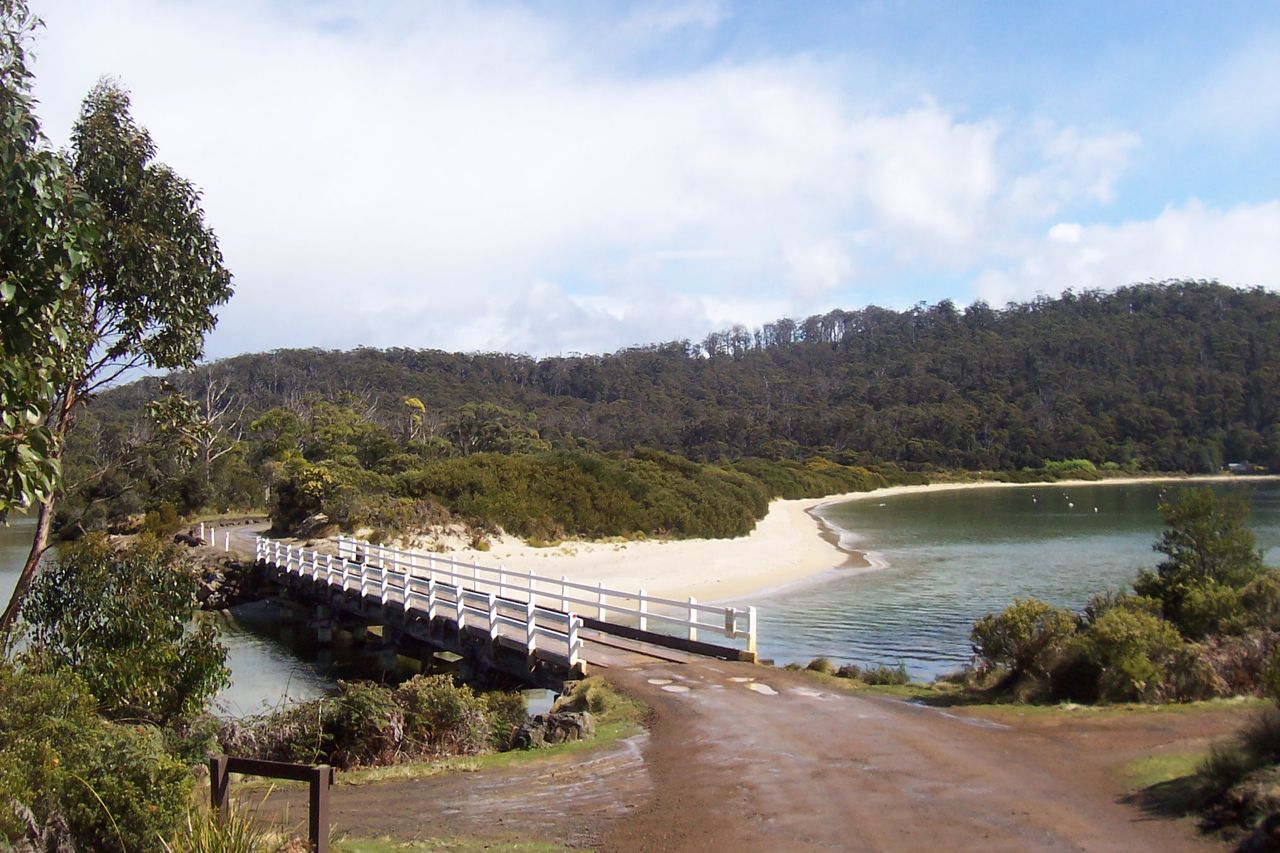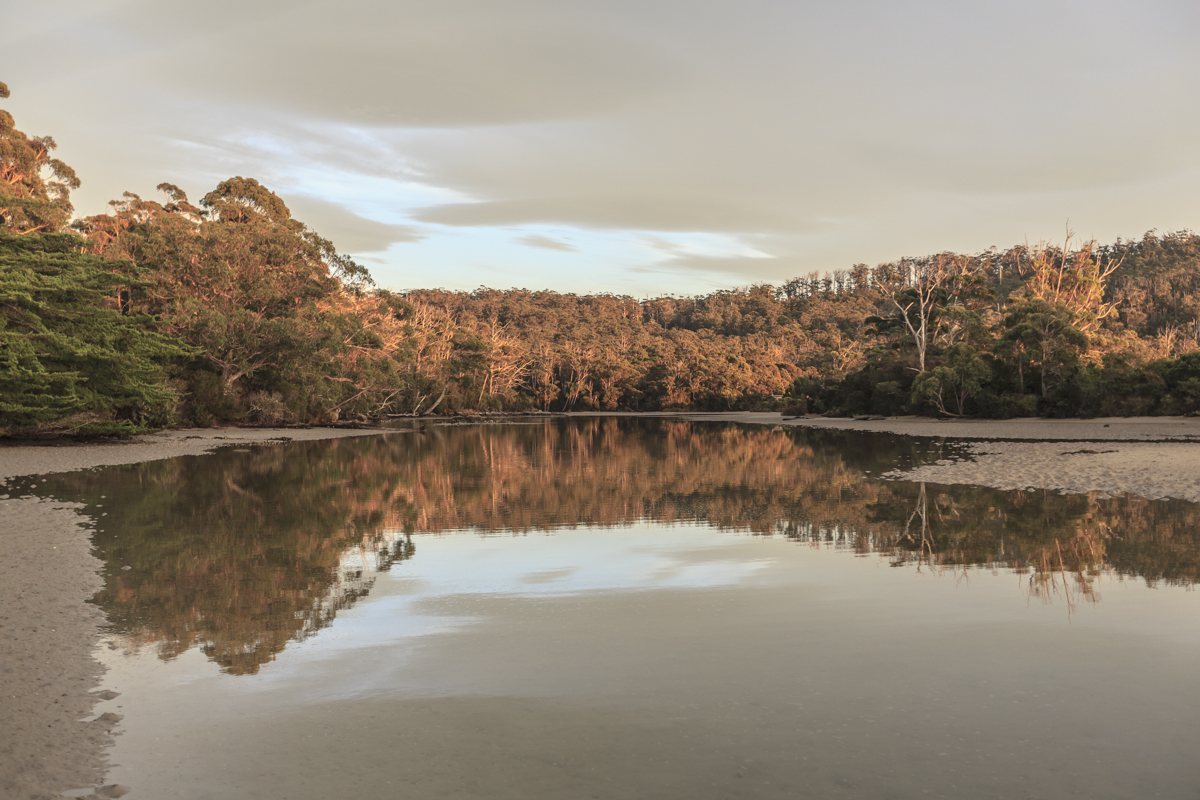Cockle Creek, Tasmania on:
[Wikipedia]
[Google]
[Amazon]
Cockle Creek is the farthest point south one can drive in Australia. It is located on


 French explorer,
French explorer,
Input welcome on Cockle Creek Site Plan
', Parks and Wildlife Service Tasmania, 17 March 2008. Accessed 19 October 2008
Recherche Bay
Recherche Bay ( ) is an oceanic embayment, part of which is listed on the National Heritage Register, located on the extreme south-eastern corner of Tasmania, Australia. It was a landing place of the d’Entrecasteaux expedition to find missin ...
on the edge of the Southwest National Park
Southwest National Park is an Australian national park located in the south-west of Tasmania, bounded by the Franklin-Gordon Wild Rivers National Park to the north and the Hartz Mountains National Park to the east. It is a part of a chain of ...
, part of the Tasmanian Wilderness
The Tasmanian Wilderness World Heritage Area, abbreviated to TWWHA, is a World Heritage Site in Tasmania, Australia. It is one of the largest conservation areas in Australia, covering , or almost 25% of Tasmania. It is also one of the last ex ...
World Heritage Area
A World Heritage Site is a landmark or area with legal protection by an international convention administered by the United Nations Educational, Scientific and Cultural Organization (UNESCO). World Heritage Sites are designated by UNESCO for h ...
.
There are no shops or other facilities in the settlement, but a campground is located in the National Park with public toilets and a public phone. The National Park Ranger's office is only staffed intermittently. Main activities are camping
Camping is an outdoor activity involving overnight stays away from home, either without shelter or using basic shelter such as a tent, or a recreational vehicle. Typically, participants leave developed areas to spend time outdoors in more na ...
, fishing
Fishing is the activity of trying to catch fish. Fish are often caught as wildlife from the natural environment, but may also be caught from stocked bodies of water such as ponds, canals, park wetlands and reservoirs. Fishing techniques inclu ...
, birdwatching
Birdwatching, or birding, is the observing of birds, either as a recreational activity or as a form of citizen science. A birdwatcher may observe by using their naked eye, by using a visual enhancement device like binoculars or a telescope, by ...
and bushwalking
Hiking is a long, vigorous walk, usually on trails or footpaths in the countryside. Walking for pleasure developed in Europe during the eighteenth century.AMATO, JOSEPH A. "Mind over Foot: Romantic Walking and Rambling." In ''On Foot: A Histo ...
.
Arts Tasmania with the Tasmania Parks and Wildlife Service
Tasmania Parks and Wildlife Service is the government body responsible for protected areas of Tasmania on public land, such as national parks, historic sites and regional reserves. Historically it has also had responsibility for managing wildl ...
offers an artists residency program at Cockle Creek "for an individual or collaboration of practising artists working in any art form to develop their work in response to the natural environment of Tasmania."
Bushwalking
The area is known for its scenic beauty of deserted white beaches and turquoise waters of Recherche Bay and a variety of short and multi-day bushwalks including the end of the 82 kmSouth Coast Track
The South Coast Track is a bushwalking track located in the South Coast region of Tasmania, Australia. The track traverses remote wilderness within the Southwest National Park, part of the Tasmanian Wilderness World Heritage Site, and is manage ...
, recommended for experienced bushwalkers equipped for wilderness walking.
A bronze sculpture of an infant southern right whale and interpretive sign on a small promontory a 5-minute walk from the car park explains the area's history of settlement around bay whaling, timber getting and coal mining. Longer walks include to the Fishers Point Navigation Light and ruins of the Pilot Station
Pilot Station ( esu, Tuutalgaq) is a city in Kusilvak Census Area, Alaska, United States. The population was 568 at the 2010 census, up from 550 in 2000.
Geography
Pilot Station is located at (61.936050, -162.883403), on the northern bank of t ...
and a track to South East Cape
The South East Cape is a cape located at the southernmost point of the main island of Tasmania, the southernmost state of Australia. The cape is situated in the southern and south-eastern corner of the Southwest National Park, part of the Tasma ...
for cliff-top views of the Southern Ocean
The Southern Ocean, also known as the Antarctic Ocean, comprises the southernmost waters of the World Ocean, generally taken to be south of 60° S latitude and encircling Antarctica. With a size of , it is regarded as the second-small ...
and Maatsuyker Island.
History
Tasmanian Aborigines
The Aboriginal Tasmanians (Palawa kani: ''Palawa'' or ''Pakana'') are the Aboriginal people of the Australian island of Tasmania, located south of the mainland. For much of the 20th century, the Tasmanian Aboriginal people were widely, and ...
valued this region for the seals, shellfish and bush hunting it provided during the warmer months, with evidence of many shell middens in the area.


 French explorer,
French explorer, Bruni D'Entrecasteaux
Antoine Raymond Joseph de Bruni, chevalier d'Entrecasteaux () (8 November 1737 – 21 July 1793) was a French naval officer, explorer and colonial governor. He is perhaps best known for his exploration of the Australian coast in 1792, while ...
sailed his two ships, the ''Recherche'' and ''Esperance'', into Recherche Bay in 1792 and again in 1793 on a scientific and botanical expedition. He subsequently named the bay after one of his ships. In 2003 the remains of a garden planted by the French were found and a reserve was created to protect the area, and subsequent archeological sites associated with the expedition have also been located.
The region provided an important port of call for ships transporting convicts to the Sarah Island Penal Colony in Macquarie Harbour
Macquarie Harbour is a shallow fjord in the West Coast region of Tasmania, Australia. It is approximately , and has an average depth of , with deeper places up to . It is navigable by shallow-draft vessels. The main channel is kept clear by th ...
on the West coast of Tasmania from 1822 to 1834, when sealers, whalers and loggers visited the area and settled to extract Huon pine
''Lagarostrobos franklinii'' is a species of conifer native to the wet southwestern corner of Tasmania, Australia. It is often known as the Huon pine or Macquarie pine, although it is actually a podocarp (Podocarpaceae), not a true pine (Pinace ...
, or conduct bay whaling in Recherche Bay. During the 1830s there were four whaling stations at Cockle Creek. In 1836 a pilot station
Pilot Station ( esu, Tuutalgaq) is a city in Kusilvak Census Area, Alaska, United States. The population was 568 at the 2010 census, up from 550 in 2000.
Geography
Pilot Station is located at (61.936050, -162.883403), on the northern bank of t ...
was set up on Fisher's Point, the southern headland to Recherche Bay, but was abandoned by 1851. During the 1840s the Crown granted seven leases for the establishment of bay whaling stations in Recherche Bay. But whales had been hunted with pregnant cows and calves indiscriminately slaughtered. Sperm whales and southern right whales were the main species hunted. By the 1850s bay whaling was in fast decline with the decimation of breeding whale populations using the bay to calve and the advent of deep sea whaling.Explanatory sign at Cockle Creek, near the Whale Sculpture, on the history of the area. Seen 29 September 2008
The settlement numbered more than 2000 people at its peak with surveying for a town called Ramsgate in an advanced stage. As whaling started to decline, timber-getting became an important activity with wooden tramways transporting logs to sawmills at Cockle Creek, Catamaran and Leprena. But gradually the good timber became less accessible and coal was discovered enabling the tramways to transport coal for export by ship at Evoralls Point, just north of Cockle Creek. Eventually the coal seam dwindled, causing people to drift away.
Ecotourism development controversy
In 2004 Melbourne property developerDavid Marriner
David Marriner is an Australian property developer and former theatre owner.
A controversial figure in his business dealings, Marriner is credited with revitalising Melbourne's East End theatre district in the 1980s and 1990s through renovating th ...
proposed building a $15 million eco-tourist complex at Cockle Creek East at Planter Beach within the National Park but outside the World Heritage Area which provoked some controversy. As a result of protests, the developer decided in December 2006 to pursue approval for construction of the main lodge building and carpark development on private land adjoining the National Park.
A development of a new site plan for Cockle Creek and Recherche Bay, and the still proposed resort at Planter Beach, Cockle Creek East, was announced in March 2008.Input welcome on Cockle Creek Site Plan
', Parks and Wildlife Service Tasmania, 17 March 2008. Accessed 19 October 2008
References
{{Southern Tasmania , state=autocollapse Rivers of Tasmania Southern Tasmania Whaling stations in Australia